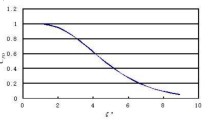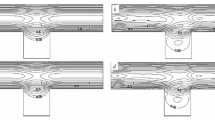Abstract
In single-phase polymer flooding experiments it has repeatedly been observed that the average velocity of the polymer molecules is higher than the average velocity of the water molecules. This effect is incorporated in many conventional Enhanced Oil Recovery (EOR) simulators by the introduction of a constant velocity enhancement factor. In this paper we show that, in absence of dispersion, a constant enhancement factor in the mathematical model for two-phase polymer flow (Buckley--Leverett displacement) leads to ill-posedness of the model equations. We propose a saturation dependent enhancement factor, derived from a model based on percolation concepts, for which this problem does not occur.
Similar content being viewed by others
References
Allen, M. B., Behie, G. A. and Trangenstein, J. A.: 1988, Multiphase Flow in Porous Media, Lecture Notes in Engineering 34, Springer-Verlag, New York.
Bedrikovetsky, P. and Bruining, J.: 1995, A percolation based upscaling technique for viscous force dominated waterflooding in uncorrelated heterogeneous reservoirs, in: Eight European Symposium on Improved Oil Recovery, pp. 316–326.
Bell, J. B., Trangenstein, J. A. and Shubin, G. R.: 1986, Conservation laws of mixed type describing three-phase flow in porous media, SIAM J. Appl. Math. 46, 1000–1018.
Davis, J. C.: 1986, Statistics and Data Analysis in Geology, Wiley, New York.
Gilham, J. R. and MacMillan, D. J.: 1987, Improved interpretation of the inaccessible pore-volume phenomenon, SPE Formation Evaluation, pp. 442–448.
Chun Huh and Scriven, L. E.: 1971, Hydrodynamic model of steady movement of a solid/liquid/fluid contact line, J. Colloid Interface Sci. 35, 85–101.
Jennings, R. R., Rogers, J. H. and West, T. J.: 1971, Factors influencing mobility control by polymer solutions, J. Petrol. Technol., 391–401.
Ligthelm, D. J.: 1996, The effect of polymer velocity enhancement by excluded pore volume on the efficiency of polymer flooding, Submitted for publication by SPE.
Patton, J. T., Coats, K. H. and Colegrove, G. T.: 1971, Prediction of polymer flood performance, Soc. Petrol. Eng. J. 11, 72–84.
Pope, G. A.: 1980, The application of fractional flow theory to enhanced oil recovery, Soc. Petrol. Eng. J. 20, 191–205.
Small, H.: 1974, Hydrodynamic chromatography, a technique for size analysis of colloidal particles, J. Colloid Interface Sci. 48, 147–161.
Sorbie, K. S.: 1991, Polymer-Improved Oil Recovery. Blackie, Glasgow.
Sorbie, K. S., Parker, A. and Clifford, P. J.: August 1987, Experimental and theoretical study of polymer flow in porous media, SPE Reservoir Eng., pp. 281–304.
Teeuw, D. and Hesseling, F. Th.: 1980, Power-law flow and hydrodynamic behaviour of polymer solutions in porous media, SPE-8982, 73–82.
Author information
Authors and Affiliations
Rights and permissions
About this article
Cite this article
Bartelds, G.A., Bruining, J. & Molenaar, J. The Modeling of Velocity Enhancement in Polymer Flooding. Transport in Porous Media 26, 75–88 (1997). https://doi.org/10.1023/A:1006563532277
Issue Date:
DOI: https://doi.org/10.1023/A:1006563532277




